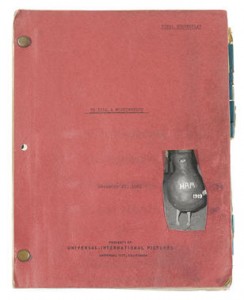Interview: Leonard Maltin on His New Classic Movie Guide
Posted on October 25, 2015 at 3:10 pm
The third edition of Leonard Maltin’s indispensible guide to older movies is now called Turner Classic Movies Presents Leonard Maltin’s Classic Movie Guide: From the Silent Era Through 1965. It is even more important than ever in the era of universal accessibility to the classics (and the enjoyable non-classics) via cable and Netflix, and it is easier to use than ever if you have a Kindle. It was a thrill to get a chance to interview Maltin, not only one of the most knowledgeable and thoughtful film historians of all time, but the very essence of a gentleman, gracious and considerate. His Maltin on Movies podcast is a pleasure to listen to, especially when his daughter Jessie is included.

When you and I were young, the quest to find classic old movies and neglected gems was, well, like something out of a movie. Did you take any extraordinary measures or have any adventures in tracking down movies you wanted to see?
When I was a kid, I sometimes forced myself to go to sleep early, set the alarm for 2am, and woke up to watch a film on the late, late show. I had to keep the volume down so I wouldn’t wake the rest of the household. Then I had to try to get back to sleep so I could function in school the next day—which wasn’t easy. I never could have foreseen that there would be a day when thousands of movies were easily and instantly accessible on video or through streaming. The question is whether or not today’s young people are curious to see, or seek out, older films.
How has the broad availability of movies on DVD, cable, and streaming changed the questions you get about movies? How as it changed the way people think about movies?
I worry that people accept the availability of movies at home as an adequate way to watch them and don’t value the opportunity to see vintage films on a big screen—the way they were meant to be seen. But I think the biggest change is that people can now obsess about movies they like and watch them over and over again. They’ve memorized some films and know them much more intimately than I do. I don’t have the luxury of doing that because I try to keep up with the latest releases and also enjoy diving into films of the past.
How has the style of acting changed since the classic era covered in your book? Which actors do you think come across more as relics of their eras and which do you think still seem timeless?
Some actors of the 1930s and 40s used a declamatory style of acting that came from the stage, while others had a more naturalistic approach and delivery. I don’t think Humphrey Bogart or Spencer Tracy are dated at all.
You have very limited space to write about each film. Once you have indicated the plot and quality, what are some of the elements you like to point out to readers? Cinematography? A great performance in a supporting role?
The answer is: whatever stands out to us. If the cinematography is exceptional, we like to point that out, but the same is true of a great music score, or a scene-stealing performance in a supporting role.
You have from the beginning been a stickler for getting the movie’s running time right. How do you get the definitive number?
Nowadays it’s easy with access to DVDs and downloads. In the past it was a great challenge, because no two sources seem to agree. I once asked a guy at United Artists how they determined accurate running times for films in their library and he said, “Uh… we used your book.” It was flattering, of course, but not terribly useful.
I enjoyed your podcast discussion with your daughter about “comfort movies.” What are some of your favorites and what makes them so comforting?
Often, it’s movies I saw while growing up. They’re like old friends, in a way. When I revisit Singin’ in the Rain or Yankee Doodle Dandy or any number of others, I’m not just enjoying the films all over again but recapturing my youth, I suppose.

Sherlock Holmes has been portrayed more times on screen than any other fictional character. Who is your favorite?
I grew up on Basil Rathbone as Holmes with that wonderful character actor Nigel Bruce as Dr. Watson and retain a special fondness for them. But I enjoy and appreciate many other Holmses over the years—the latest being Ian McKellen in Mr. Holmes.
Abraham Lincoln has been portrayed on screen more times than any other historical character. Who is your favorite?
That’s another one that’s hard to choose. Daniel Day-Lewis was magnificent in Steven Spielberg’s recent film, but that doesn’t prevent me from still enjoying Henry Fonda in John Ford’s Young Mr. Lincoln.
One thing I especially enjoy in your write-ups is your mention of unexpected appearances, sometimes by directors but usually by actors who were not yet famous. Do you have a favorite example?
It’s always fun to spot an up-and-coming actor in an early role. I can’t pinpoint a favorite off the top of my head.
When you and the brain trust that works with you on this book disagree about the quality of a film, how do you decide the rating?
That’s the benefit of being editor-in-chief: I have the final say.

